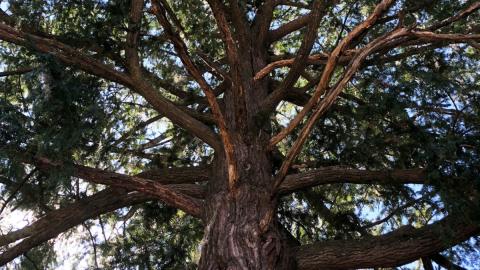
By Janet Marinelli
The Florida torreya is North America’s most endangered conifer, with less than one percent of its population remaining. Now, scientists are mounting a last-ditch effort to save the torreya and are considering using new gene-editing technologies to protect it.
Edward O. Wilson clambered partway down a slope in the Florida Panhandle, aided by a park ranger and trailed by a few dozen scientists, conservationists, and local landowners. The group had gathered in Torreya State Park, a landscape of dazzling botanical diversity along the upper Apalachicola River, as part of a whirlwind two-day meeting early this month to ponder the fate of its most storied tree. As the wind gusted through leafless branches, the lanky, white-haired Wilson, at 88 years of age still one of the most brilliant biologists of his generation, planted a seedling of the Florida torreya, North America’s most endangered conifer.
Wilson first visited the Apalachicola bluffs in 1957, as a self-described “young guy” with a new position at Harvard University, on an ant-collecting trip in Florida. “I came here,” he recounted, “the way you would go to Paris to visit a cathedral. I just had to see the torreya.” The trees had already begun their steep decline.
More than 60 years later Wilson was back. This time he declared the site “is not only a cathedral, but also a battleground at which one of the greatest events in American history will take place” — a turning point, as he sees it, in the planetary struggle to slow biodiversity loss.
Last spring, another “young guy” was at Torreya State Park on a camping trip with his lab. University of Florida forest pathologist Jason Smith “couldn’t believe how much worse the torreyas were” than when he had seen them the year before. “The population was crashing.” Smith, who has reddish brown hair and a bundle of energy, decided to assemble a team to reflect on the meaning of the species’ imminent demise, to catalog the “torreya tree of life” — all living things with which it associates in the wild — and to plan a last-ditch effort to save it.
“This is a now or never moment for the species,” he says.

